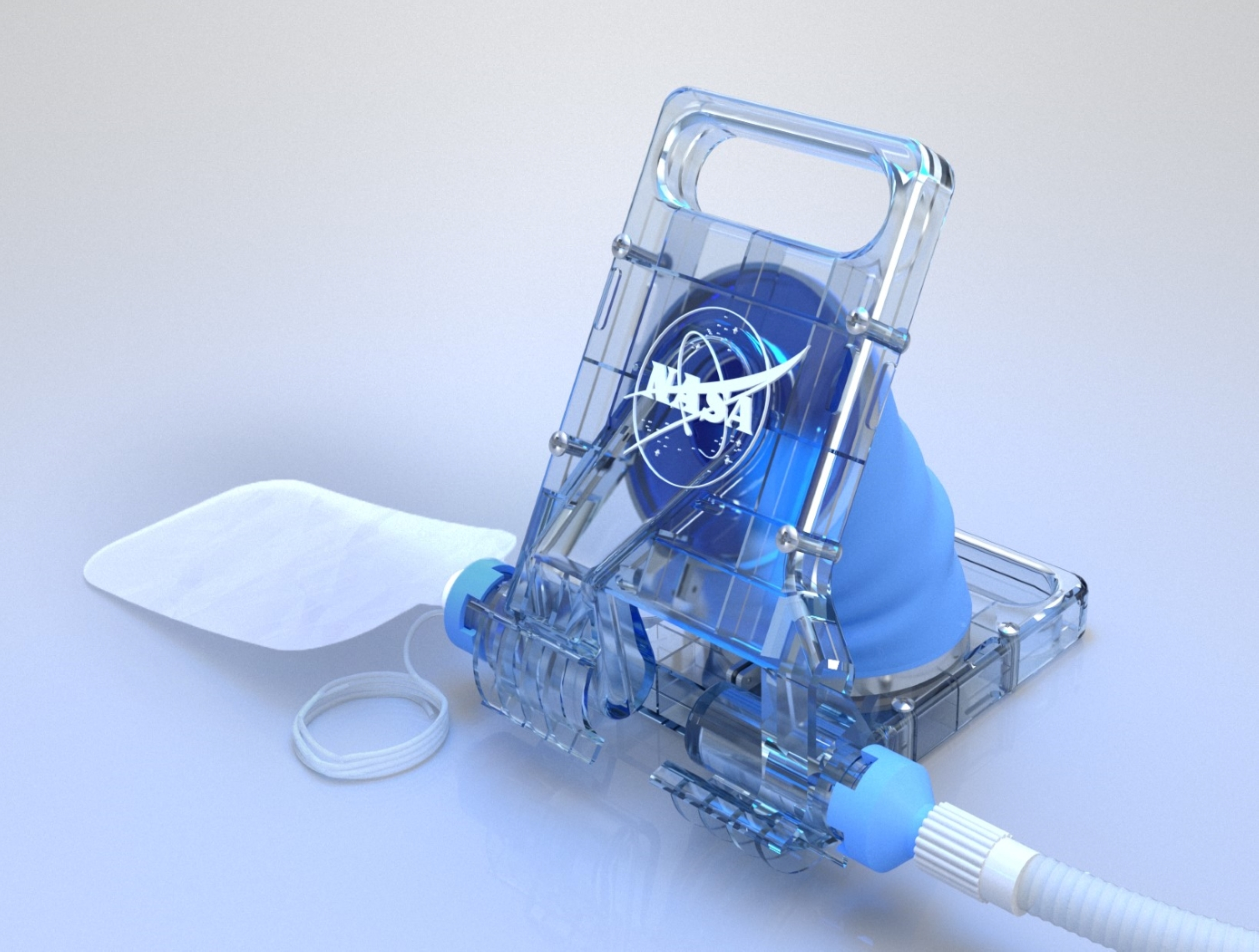Search
Health Medicine and Biotechnology

Human-Powered Ventilator
In space there are a limited number of care providers, and those providers are not always clinicians with extensive medical training. Space travel also has limited room to provide care and limited consumables. The Human-Powered Ventilator is compact, portable, and easy to assemble. It is designed so that users can implement hand and arm movements to pump the bellows between two hinged, clamshell-like panels back and forth to provide positive pressure ventilation to the patient. A light spring is incorporated into the design to assist in expanding the bellows, drawing air out of the patient’s lungs, and reducing the physical load on the operator without compromising the tactile feel necessary for proper usage. The airflow can be supplemented with prescribed medical vapors, oxygen, etc. via standard industry fittings.
The Human-Powered Ventilator is TRL 6 (system/subsystem prototype has been demonstrated in a relevant environment) and it is now available for your company to license. Please note that NASA does not manufacture products itself for commercial sale.
Mechanical and Fluid Systems

Miniaturized Electrospray System
NASA's miniaturized electrosprayer offers a new technology that may support the next generation of portable and/or of precise electrosprayers. Developed for applying water to plants in space where gravimetric methods do not apply, this sprayer may also enable the delivery of a precise liquid for terrestrial uses without relying on pressurized air.
Electrospraying (aka electrostatic spraying) is a technique where droplets are charged to enhance surface adhesion and coverage efficiency. Various electrospray variants are used in a host of industries to coat auto parts, apply pesticides and nutrients to crops, and more. Commercially-available electrosprayers are generally large, air-assisted devices that traverse up to 20 feet in the air and require large amounts of liquid and electrical power.
NASA's miniaturized electrosprayer system does not require compressed air, uses far less liquid, and concentrates the mist in an area less than 2 feet away. The system only needs enough power to charge the droplets at the spray nozzle, so it may use small batteries (e.g., AAA batteries). The new electrosprayer implements a unique nozzle design that imparts a high charge-to-mass ratio on the spray and increases coverage efficiency. Thus, the miniaturized electrosprayer can be placed inside a portable, handheld sprayer or be used as a stationary device for a wide range of uses, particularly when spraying expensive chemicals (e.g., plant nutrients) and when precise, efficient spraying is required (e.g., industrial coatings, disinfectants, etc.).
Health Medicine and Biotechnology

Electrochemical Sensors Based on Enzyme-Linked Immunosorbent Assay
NASA’s electrochemical Enzyme-Linked Immunosorbent Assay (ELISA) microelectrode array biosensor advantageously incorporates a microbead detection construct, coupled with a magnetic immobilization construct, which substantially increases the signal sensitivity of a sensor. The magnetic immobilization construct draws the microbead detection construct to an electrode detection surface, enhancing signal sensitivity. By concentrating the signaling molecules close to the electrode detection surface, electrochemical redox cycling is achieved by reducing the distance between the two, allowing for regeneration of reporter molecules.
Whereas a traditional ELISA testing exhibits five to ten signaling molecules per probe molecule binding event, the present electrochemical ELISA-based biosensor testing exhibits up to 4,857 signaling molecules per probe molecule binding event. The model bead construct exhibits a more than 6.75-fold in increased measured signal, and more than 35.7-fold improvement in signal sensitivity. When compared to traditional optical ELISA, the present invention improves the limit of detection by up to a factor of 60.5.
NASA’s electromagnetic ELISA-based biosensor can be used for the detection of SARS-CoV-2 virus to enhance Covid-19 testing during the early phases of infection. The technology may also be modified to detect other biomarkers.
Sensors

Systems and methods employing nanomaterial sensors for detecting conditions impacting a Volatile Organic Compounds (VOCs) profile in breath
The technology involves a sophisticated system designed to detect conditions through the analysis of exhaled breath, utilizing an array of nanomaterial sensors fabricated upon a standard printed circuit board with interdigitated electrodes. These sensors are configured to interact with a sample gas that contains various Volatile Organic Compounds (VOCs) associated with a variety of biological conditions. Each sensor consists of nanomaterials, such as carbon nanotubes, composite nanotubes, nanoparticle-doped nanotubes, or polymer-coated nanotubes, all disposed on an electrically conductive structure. These sensors are highly sensitive to specific VOCs at a broad spectrum of concentrations, and each sensor generates a unique measurable electrical signal on interaction with VOCs in the breath that reflects the presence and concentration of specific components in the sample gas. The previously nanosensor diagnosis technology has been further developed to identify 64 specific formulations of nanomaterials that exhibit unique and varying sensitivities to VOCs, which enables unique response signatures to be developed for a wide range of VOCs. A single device may be developed using these principles to detect a variety of health conditions and diseases.



